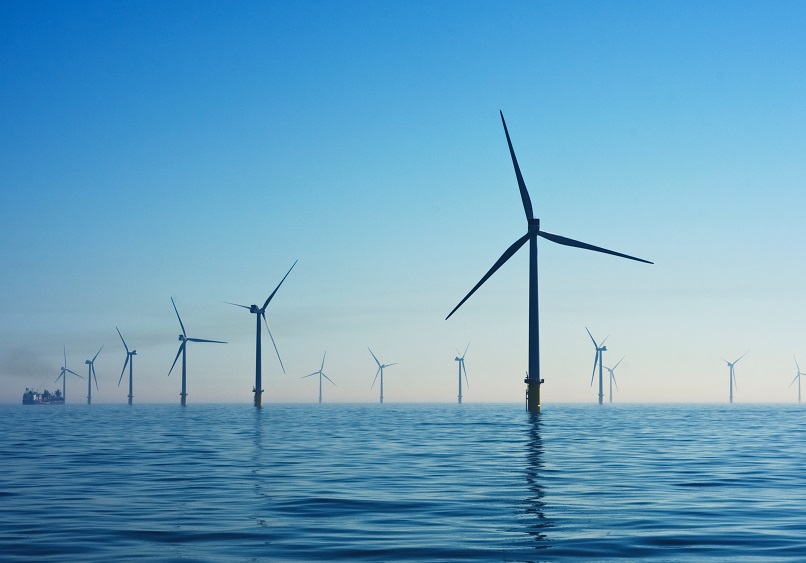Offshore generation of hydrogen at far-from-shore wind farms

|
| To achieve a zero-carbon future, alternative methods of delivering energy, including its generation and distribution, must be seriously investigated for both technical and commercial viability. Maritime Expert Panel member, Neil Glover, discusses the opportunities for far-from-shore wind farms, and the opportunities for hydrogen that may result. Photo: Rampion windfarm, Nicholas Doherty, Unsplash |
Contents |
[edit] Introduction
As we aspire toward a zero-carbon future, wind farms have already been identified as an important component of our energy mix.
Far-from-shore wind farms are now becoming technologically possible, but face significant challenges. What is not often appreciated is that these would also enable the wider use of hydrogen. An understanding of key aspects of far-from-shore wind turbine design is necessary to appreciate the dual opportunities that could be realised.
[edit] Far-from-shore wind farms
In June 2015, the Carbon Trust report to the Scottish Parliament identified that the UK would require up to 55GW of wind energy by 2050 and that it would be necessary to move to deeper offshore waters to meet this goal. However, moving further from shore does not happen without overcoming some significant engineering challenges.
[edit] Challenges ahead
The move to deeper water will require the development of a new design for turbine foundation. The move to far-from-shore locations also adds new challenges.
Electrical transmission from near-shore wind farms is normally done using high-voltage alternating currents (HVAC). However, as transmission distances approach 100 miles, this option becomes less practical and High Voltage Direct Current (HVDC) systems may be required. HVDC systems require considerably larger and more costly offshore and onshore transformer and converter substations.
[edit] Alternative option – hydrogen generation far from shore
This is where the opportunity for hydrogen comes in. The benefits of hydrogen gas are striking. It emits no carbon dioxide and, if used more widely, would have a major impact on the decarbonisation of our fuel supply.
Heating and transport in particular are major CO2 emitters, and would be ripe for decarbonisation if hydrogen could be used effectively to deliver the offshore wind energy to where it is needed.
Hydrogen is a clean energy vector, whether generated by Steam Methane Reforming and Carbon Capture (SMR+CC) or by one of the several methods of electrolysis. New transportation methods are needed if we are to tap into far-from-shore energy to meet our sustainable, clean energy aspirations.
A far-from-shore wind farm, using floating wind turbines, has the potential to use decommissioned offshore platforms originally constructed for oil and gas production. The Brent platforms are an example that could be used as a hub for the facilities to produce hydrogen by electrolysis.
[edit] Download the ICE briefing paper
To explore this issue further, Neil Glover has authored an ICE briefing sheet which delves deeper into the opportunity and challenges ahead for hydrogen development, presenting some exciting alternative solutions to generate and distribute far from shore.
[edit] About this article
This article was written by ice.org.uk Neil Glover, ICE Maritime Expert Panel member. It previously appeared on the ICE website in November 2019 and can be accessed HERE.
Other articles by the ICE on Designing Buildings Wiki can be accessed HERE.
[edit] Related articles on Designing Buildings Wiki
- Environmental Impact Assessment.
- Nationally significant infrastructure projects.
- Planning now for hydrogen.
- Renewable energy.
- Steam methane reforming.
- Strategic Environmental Assessment.
- Wind Energy in the United Kingdom.
- Wind turbine.
[edit] External references
Featured articles and news
RTPI leader to become new CIOB Chief Executive Officer
Dr Victoria Hills MRTPI, FICE to take over after Caroline Gumble’s departure.
Social and affordable housing, a long term plan for delivery
The “Delivering a Decade of Renewal for Social and Affordable Housing” strategy sets out future path.
A change to adoptive architecture
Effects of global weather warming on architectural detailing, material choice and human interaction.
The proposed publicly owned and backed subsidiary of Homes England, to facilitate new homes.
How big is the problem and what can we do to mitigate the effects?
Overheating guidance and tools for building designers
A number of cool guides to help with the heat.
The UK's Modern Industrial Strategy: A 10 year plan
Previous consultation criticism, current key elements and general support with some persisting reservations.
Building Safety Regulator reforms
New roles, new staff and a new fast track service pave the way for a single construction regulator.
Architectural Technologist CPDs and Communications
CIAT CPD… and how you can do it!
Cooling centres and cool spaces
Managing extreme heat in cities by directing the public to places for heat stress relief and water sources.
Winter gardens: A brief history and warm variations
Extending the season with glass in different forms and terms.
Restoring Great Yarmouth's Winter Gardens
Transforming one of the least sustainable constructions imaginable.
Construction Skills Mission Board launch sector drive
Newly formed government and industry collaboration set strategy for recruiting an additional 100,000 construction workers a year.
New Architects Code comes into effect in September 2025
ARB Architects Code of Conduct and Practice available with ongoing consultation regarding guidance.
Welsh Skills Body (Medr) launches ambitious plan
The new skills body brings together funding and regulation of tertiary education and research for the devolved nation.
Paul Gandy FCIOB announced as next CIOB President
Former Tilbury Douglas CEO takes helm.
UK Infrastructure: A 10 Year Strategy. In brief with reactions
With the National Infrastructure and Service Transformation Authority (NISTA).























